The 6 Logo Types: Which One is Right for Your Business?
Your logo is the face of your business. It's the first thing people see and it's what they'll remember. But with so many different types of logos out there, how do you know which one is right for your brand? In this post, we'll dive into the world of logo types and help you understand the different options available to you.
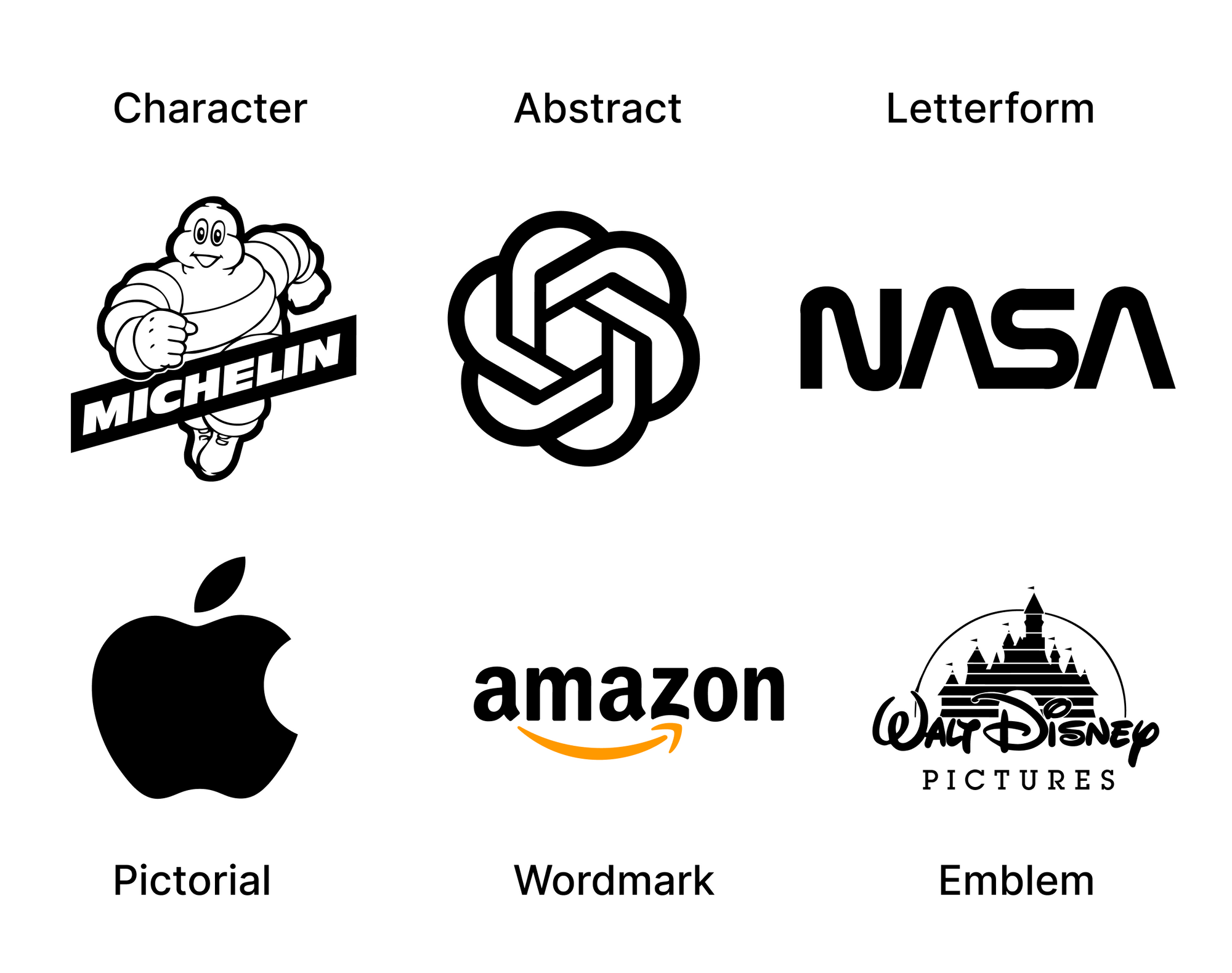
From word mark logos to pictorial mark logos, we'll explore the pros and cons of each type and provide examples to help you make an informed decision. We'll also give you some tips on how to choose the right logo for your business, based on your industry and target audience.
Finally, we'll introduce you to LogoArena, a platform where you can launch a logo design contest and receive multiple design options from professional graphic designers. Let's get started on finding the perfect logo for your business!

Understanding Logo Types
Understanding the diverse logo types is key to creating a tailor-made brand logo design. Each type caters to different branding needs, incorporating unique design elements for flexible brand representation. Choosing the right logo type is critical for brand recognition and identity. This understanding paves the way for a new logo design, supported by a search engine-driven logo maker and a dedicated support team.
WordMark Logos
When creating a brand identity, word mark logos utilize stylized typography without additional graphic elements. Ideal for businesses with a distinct name, they make a bold and easily remembered statement. Versatile and effective in various applications such as print materials and merchandise, they play a crucial role in brand recognition and differentiation.
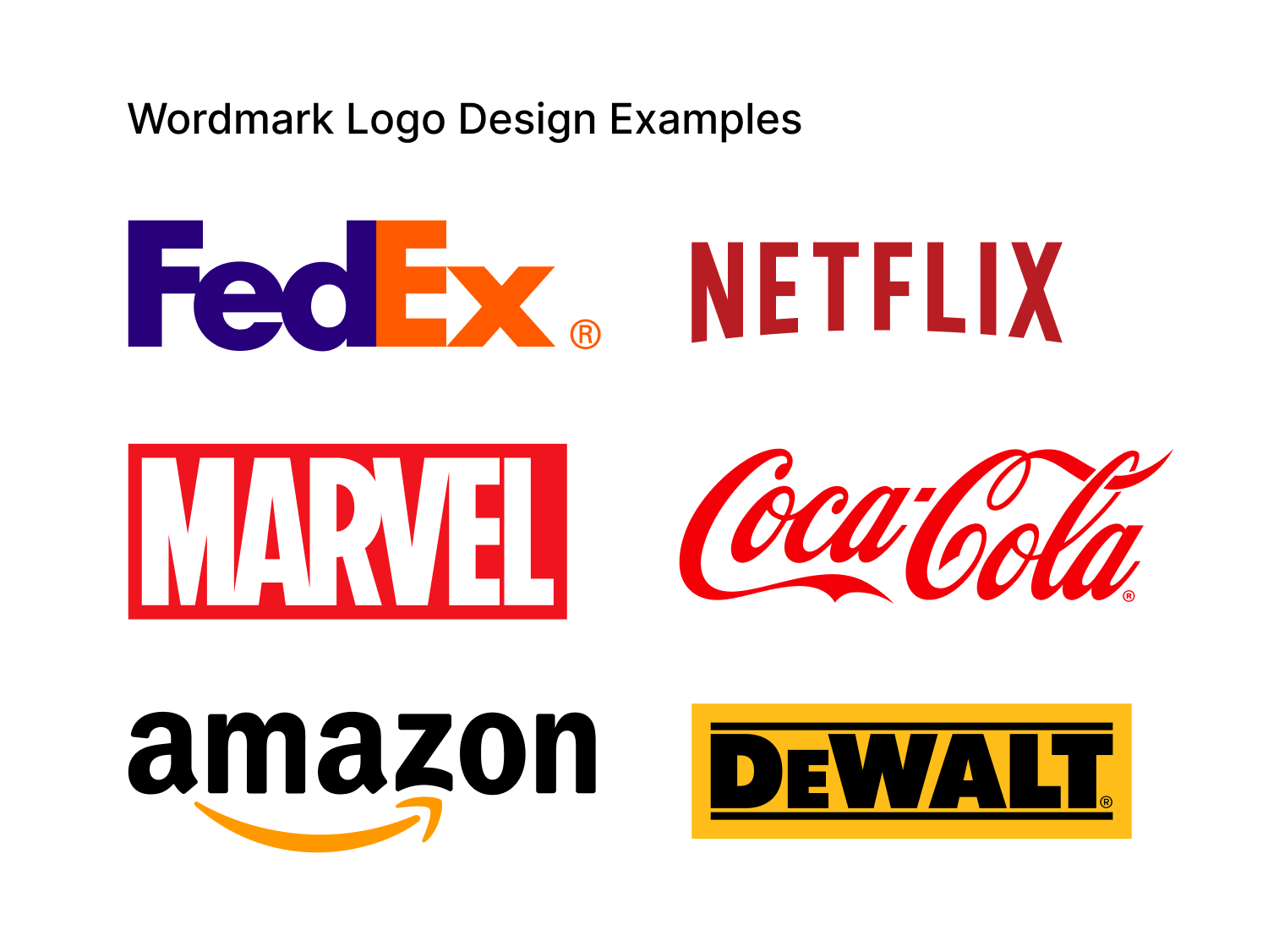
What is a wordmark logo
A wordmark logo uses text to convey the business name and brand message, known for its simplicity and easy recognition. Notable examples include Coca-Cola, Fedex and Netflix. It is ideal for businesses with short names or unique fonts, often used by well-established companies in industries that prioritize professionalism and simplicity.
Elements of a good word mark logo
When creating a word mark logo, simplicity is key. It should be easy to read, reflect the brand's personality, and use carefully selected fonts, colors, and spacing for impact. The right font is crucial for industry relevance and audience appeal. A successful word mark logo can become synonymous with the brand, fostering recognition and loyalty.
The use of colors in a word mark logo
Color choices in a word mark logo are pivotal for brand recognition. Brands align colors with their values and personality, evoking specific emotions. Bright hues convey energy, while softer ones evoke sophistication. Effective color use makes the brand memorable and distinctive, contributing to consumer perception and loyalty.
The use of fonts in a word mark logo
When creating a word mark logo, typography plays a crucial role in crafting a distinct and memorable design. It's essential for the chosen fonts to align with the brand's message and personality. Bold and simple fonts often exude a modern and clean aesthetic, while cursive or script fonts can convey elegance and sophistication. Additionally, the spacing and size of letters significantly impact the logo's overall look and readability.
Emblem Logos
Featuring the company name or initials within a badge or emblem, emblem logos exude a classic or traditional feel, conveying a sense of heritage. Versatile for various platforms, they may be challenging to reproduce at smaller sizes. Nevertheless, they are ideal for businesses with a strong brand identity or established reputation.
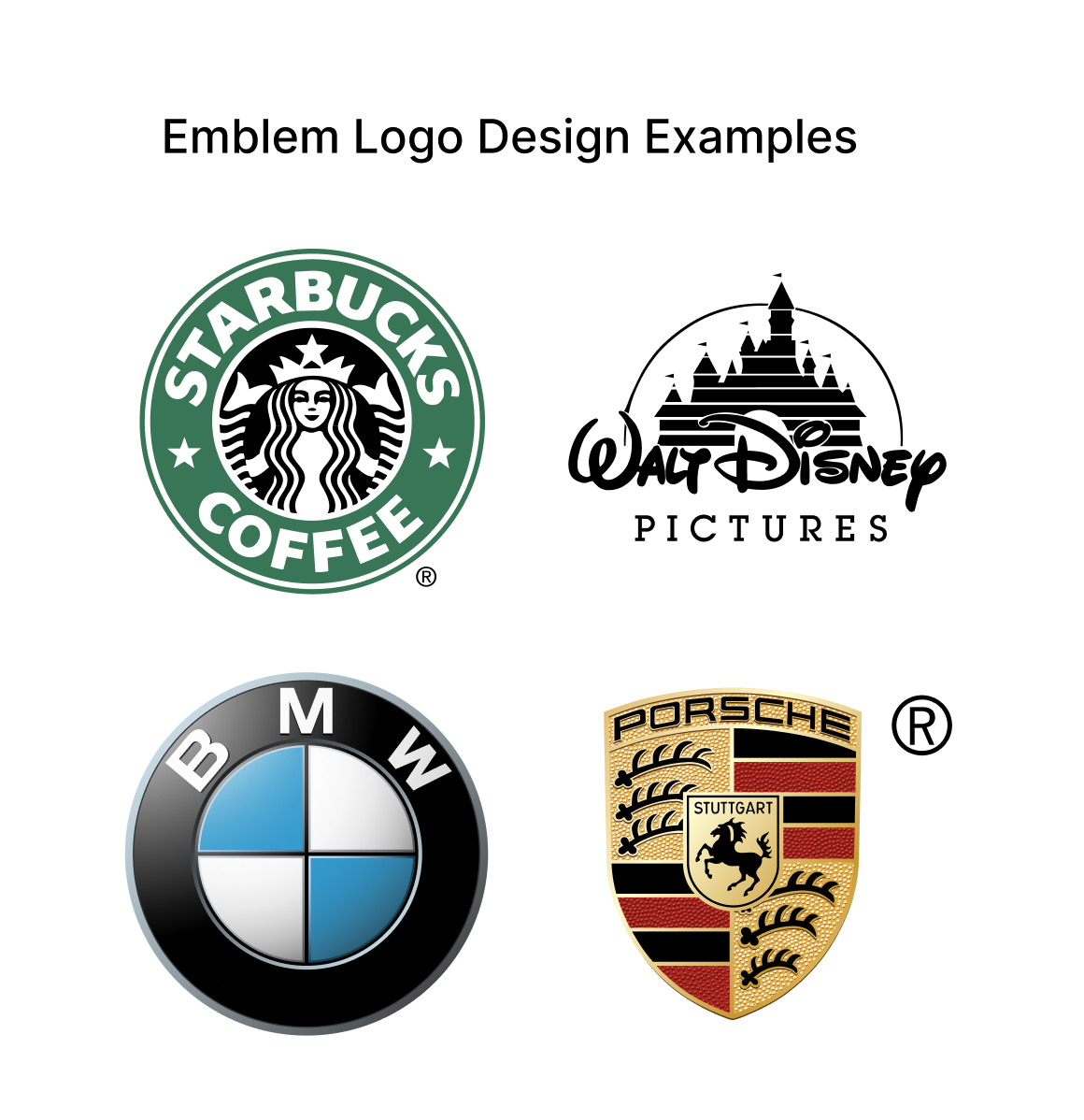
What is an Emblem Logo
Emblem logos, often featuring intertwined text and images, are utilized by organizations with strong historical significance. Visually striking but challenging to reproduce, they convey a sense of prestige and heritage. While highly detailed and versatile, they may not work as effectively across different mediums. Known examples of an emblem logo are Starbucks and Walt Disney.
The pros and cons of using an emblem logo
When considering emblem logos, it's important to weigh the advantages and disadvantages. These logos exude tradition and can be intricate, but they may lack versatility and prove challenging for scaling. Ultimately, their suitability depends on the brand's aesthetic and target audience.
Some considerations for choosing an emblem logo
When choosing an emblem logo, consider your business's brand image and heritage. Ensure the design is scalable and legible across mediums. Choose colors and fonts aligned with your brand's personality. The combination of text and symbols should create a recognizable design. Consider the complexity and versatility of the logo across various sizes and applications.
Character Logos
Character logos, also known as mascot logos, leverage characters to embody the brand, fostering deep emotional connections with consumers, especially younger demographics. However, their development demands careful execution to evade appearing unprofessional or cartoonish. Successful mascot logo examples include the Michelin Man, Wendy's and Pringles, illustrating the potential of character logos in brand representation.
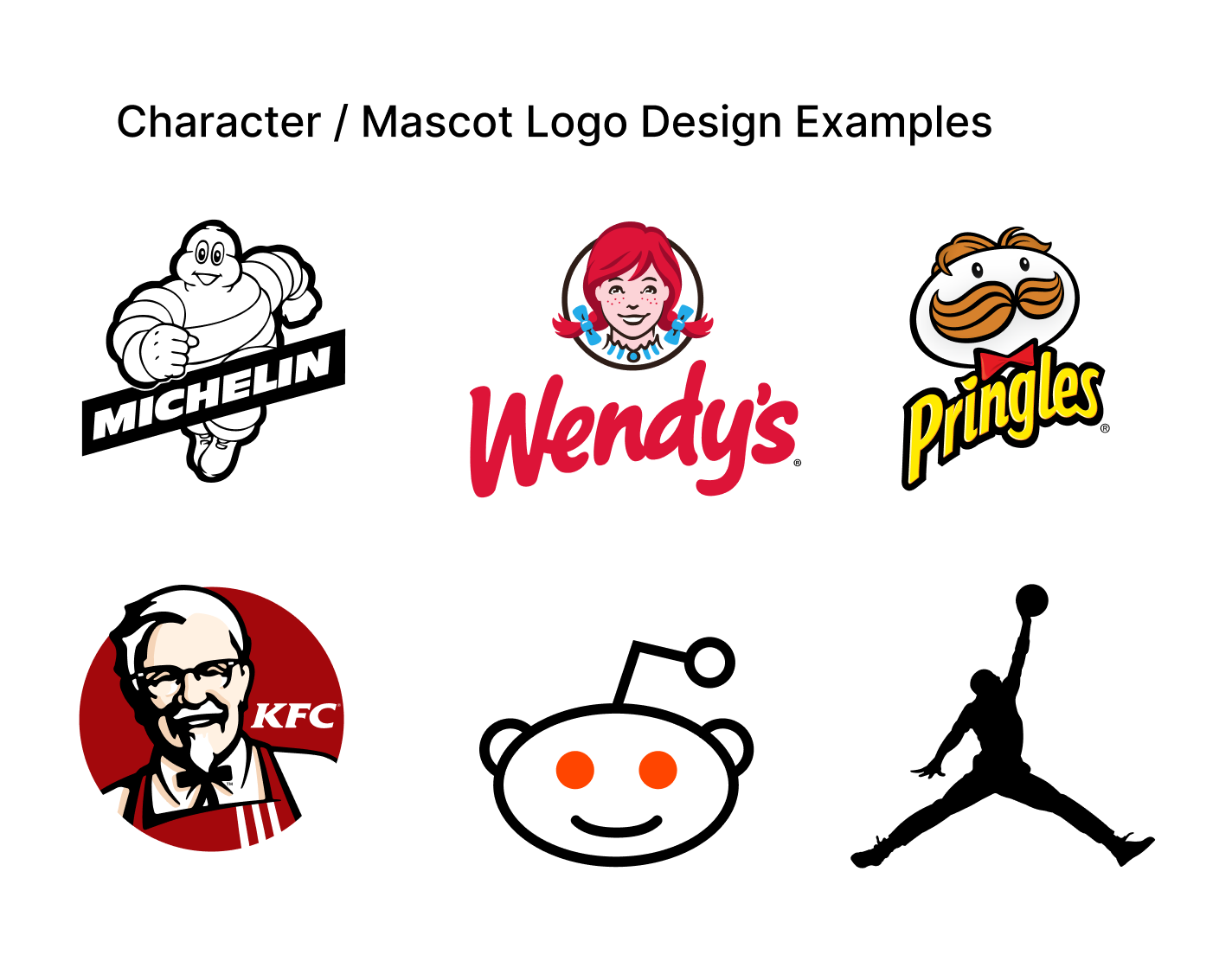
The advantages of using a character logo
When creating a brand, using a character logo offers numerous benefits. It helps in establishing a memorable and distinct brand image while evoking emotions and conveying the brand's personality. Additionally, character logos are versatile and can be used across various marketing mediums, appealing to a broader audience, including children and families. A well-designed character logo is crucial for enhancing brand recognition and identity.
What makes a character logo successful
When designing a character logo, ensuring it's memorable and recognizable is key. The character must resonate with the brand and its audience, possessing a unique trait that sets it apart. Versatility across various marketing materials is crucial, as well as evoking positive emotions towards the brand.
Different types of character logos
Character logos offer diverse options for brand representation. Mascot logos embody a brand's personality and values, while signature logos create a personal connection. Animated logos infuse life into a brand, and brand ambassador logos leverage influencers. The right choice hinges on the brand's tone, audience, and overall branding strategy.
Abstract Mark Logos
Abstract mark logos, with their simplicity and versatility, are a great choice for creating a unique visual identity. Their minimalistic nature makes them easy to recognize and adapt to various platforms. Through shapes and colors, abstract mark logos can convey emotions and values, helping businesses stand out in a crowded market. Great inspirations for successful abstract logos include OpenAi (ChatGPT), Spotify and Airbnb.

Pros and cons of abstract logos
When considering abstract logos, it's important to note their ability to create a unique brand identity and adapt to various mediums. However, they may struggle to convey a clear message or product association and can sometimes be complex for consumers to understand. Understanding the industry and target audience is crucial for effective representation.
When to use an abstract logo
Abstract logos convey innovation and creativity, ideal for tech or design businesses. Memorable and versatile, they reflect brand values but may be less direct. A professional designer can ensure uniqueness that effectively communicates your brand. Consider the emotional impact and versatility of abstract logos.
Letterform Mark Business Logos
Letterform mark logos integrate letters into the design, creating visually appealing and memorable images. They are ideal for businesses with shorter names or those looking to emphasize their initials. These logos can range from simple to intricate and offer versatility in color and font variations to match different branding needs while maintaining legibility and recognition.

The benefits of a letterform logo
When it comes to a letterform logo, the possibilities are endless. These logos make a bold statement, easily recognizable and convey professionalism. They're versatile, customizable, and timeless, serving as a wise investment for long-term branding strategies. In finance, law, or tech, they exude sophistication, setting your brand apart in a crowded market.
Characteristics of a good letterform logo
When creating a letterform logo, simplicity, memorability, and readability are crucial. The chosen font and colors should mirror the brand's identity and values, and the design must be adaptable for various marketing materials. Successful letterform logos, like IBM and HBO, exemplify these characteristics, making them easily recognizable and versatile.
Pictorial Mark Business Logos
Pictorial mark logos, often using an image or icon, are simple and easily recognizable, making them great for brand recognition. They offer versatility in size and format, but require careful consideration of colors and shapes to effectively communicate the brand's message. Depending on the brand's personality, they can be abstract or literal. Apple is probably the most well known example of a pictorial mark logo.
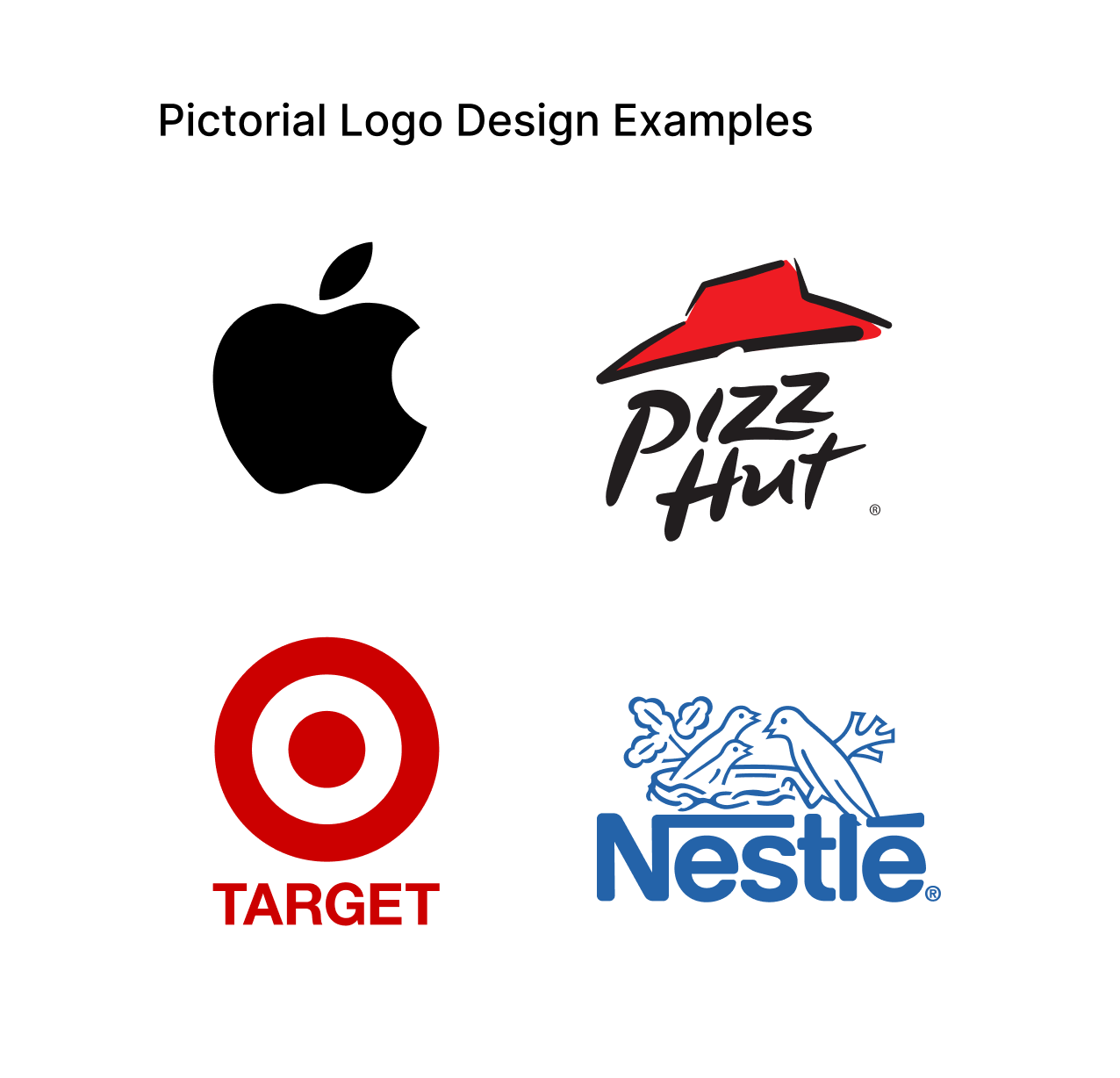
Advantages and disadvantages of pictorial logos
When considering pictorial logos, it's important to note their effectiveness in creating memorable brand associations. They are generally more recognizable and easier to remember than text-based logos. However, accurately representing the brand's identity can be challenging, as well as the legal aspects of trademarking and protection.
Types of pictorial logos
Pictorial logos convey a brand's identity through images or symbols, enhancing recognition. Abstract pictorial logos offer unique, open-to-interpretation imagery, while literal ones use realistic representations. Mascot logos employ characters for memorability. Though challenging to design, pictorial logos provide excellent branding opportunities.
When to use a pictorial logo
Pictorial logos are perfect for visually strong businesses like design or art companies. They create a memorable brand identity and convey a simple, effective message about the company. However, relevance to the business is crucial to avoid appearing generic. A professional designer can help craft a unique and effective pictorial logo for your business.
Choosing the Right Logo for Your Business
A captivating logo is crucial for brand identity, reflecting your business image and values. A professional logo designer can create a standout logo, while good logo design services offer custom solutions. Templates streamline logo file creation for various purposes, ensuring a logo that truly resonates with your business.
Factors to Consider
When crafting a logo, consider color, layout, and font. Conduct a trademark search to avoid infringement. Rely on a professional logo designer for best practices. Ensure the logo is suitable for web design, social media, and stationery. A supportive team can assist in creating a new logo.
What business logo design works for your industry
When choosing a logo type, it's crucial to consider the industry you're in. For instance, a modern logo might suit tech companies, while a traditional one may be better for a law firm. Look at successful logos in your industry for inspiration, but don't be afraid to stand out. Work with a professional designer to create a logo that fits your business.
Launching a Logo Contest on LogoArena
Launching a logo contest on LogoArena is the best way to get a great logo for your business. With a LogoArena design contest, you select the logo type you're interested in, and you get 50+ designs to choose from.

You gain instant access to a global community of talented designers. Enjoy multiple design options and affordable pricing with a money-back guarantee. Save time with high-quality results and maintain control over the entire process.
Conclusion
In conclusion, choosing the right logo type for your business is crucial for creating a strong brand identity. Each logo type has its own advantages and considerations, so it's important to understand which one aligns best with your industry and target audience.
- Word mark logos are simple and effective for conveying your business name
- Emblem logos add a sense of tradition and authority.
- Character logos can be memorable and personify your brand
- Abstract mark logos offer versatility and creativity.
- Pictorial mark logos use visuals to represent your brand
- Letterform mark logos focus on typography.
Consider the characteristics and pros and cons of each logo type before making your decision. If you're ready to find the perfect logo for your business, launch a logo contest on LogoArena and benefit from a pool of talented designers. Remember, choosing the right logo type is an investment in your brand's success.
About LogoArena Team
We're the LogoArena Team, a squad of seasoned logo design enthusiasts. With a wealth of experience, we're all about creating logos that grab attention and leave a lasting impact.
Your brand's visual identity is our playground, and we're passionate about crafting logos that resonate with your audience. Collaboration is key; we work closely with you to produce distinctive and effective logos.
In our blog, we dive into the nitty-gritty of logo design, sharing tips on color psychology, typography, logo trends, and more. So, whether you're a startup or an established business in need of a fresh logo, trust us for logo excellence!
